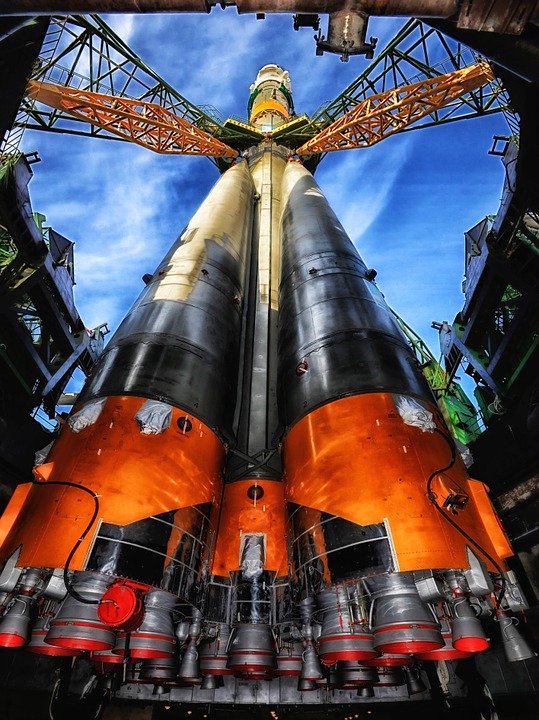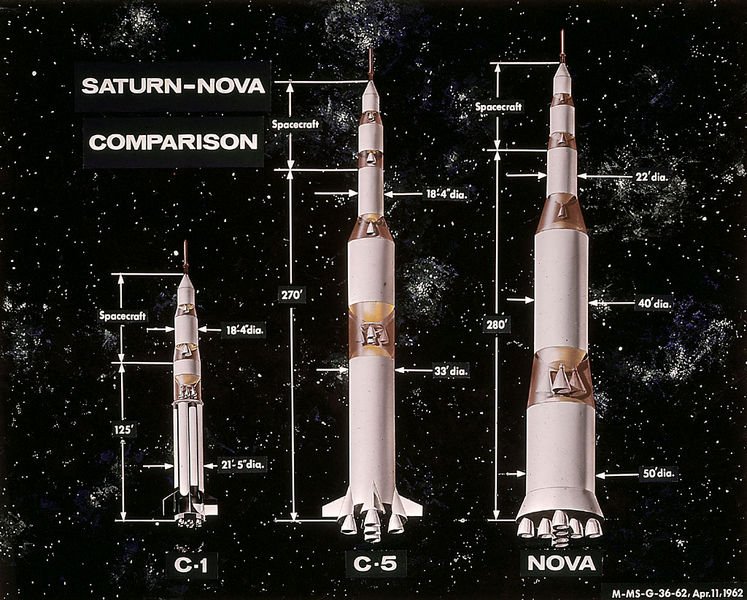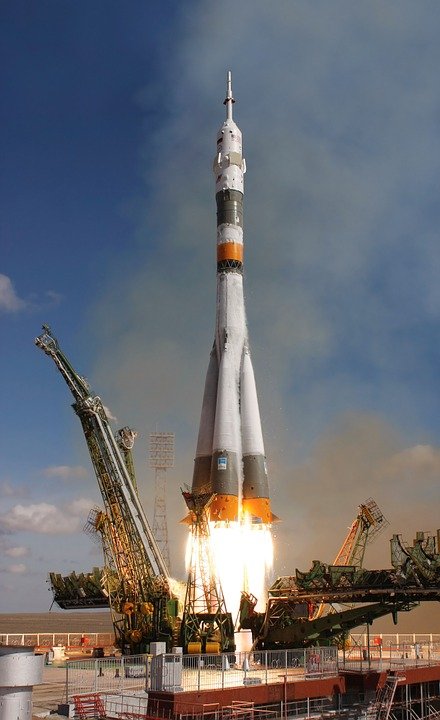Introduction
Rockets and satellites are parts of the very important and exciting technological developments of the modern world. Both instruments are most often linked to one another as the rockets are always used to lift or transport the satellites into space.

Source: Pixabay, CC0
Rockets and their components
A rocket is an engine or instrument that produces a great power. It produces more power compared to its size than any other kind of engine.
A model rocket consists of seven basic component:
- The body tube
- The launch lug
- The fins
- The engine holder
- The rocket engine
- The nose cone
- The recovery device
- A launch system or pad to get the rocket into the air.
.svg.png)
Author: fastfission, Public domain
The body tube
This is a hollow cylinder to which all the other parts are attached.
The launch lug
This is a narrow tube fastened to the side of the body tube. It guides the rocket and keeps it vertical during liftoff.
The fins
These are attached to the bottom part of the body tube just as fins are attached to a fish. They help the rockets to travel straight during flight.
The engine holder or engine mount
This is a ring cemented inside the bottom of the body tube of the rocket. It is constructed in such a way that the rocket engine fits into engine holder.
The rocket engine
This is usually in the form of a tube and contains the solid fuel or propellant.
The nose cone
It forms the top of a model rocket. Its tip has a rounded point that reduces the air resistance.
The recovery device
This is wired to return the rocket slowly to the ground after it has reached its highest point or maximum altitude called apogee. One such device is a parachute behind the nose cone.
The launch system
This consists of a launch pad and an engine ignition system with a battery.
Component parts of a Multi-stage Rocket
In the first instance, what's a Multistage Rocket?
A Multistage Rocket is a type of rocket that consists of two or more sections called stages. Each stage has a rocket engine and propellant. The entire rocket itself consists mainly of rocket engine and nose cone.

Source: Wikipedia Commons, NASA, Public domain
A rocket traveling into space requires more than one engine. The reason is that it will require a much large amount of fuel or propellant to gain the speed required to escape the Earth's gravity, and this is not economically favorable.
A multistage rocket can reach higher speed because it lightens its weight by dropping stages as it used up fuel or propellant. A system of two or more rocker engines called a multistage rocket is therefore employed.
The first rocket engine called "first stage rocket" or "booster", launches the rocket. After the propellant of this stage is used up, burnt or exhausted, the vehicle drops that section and uses the second stage, and the process repeats itself, after which the third stage rocket comes into operation.
Another component part of the rocket is the "Nose Cone". This is located at the pointed end of the entire structure of the rocket. It is in the nose cone that the astronauts and payload stay during space travel. The payload is the equipment carried by a spacecraft or rocket. It can be a satellite or other research equipment.
Launching a Multi-stage Rocket
The rocket is launched or sent off into space from a launch pad located at a special site called launch sites
The rockets are prepared for launching in a step by step process called the countdown. Each step is scheduled for a specific time during the countdown and the rocket is launched when the countdown reaches "zero". A hold may, however, occur at any stage if the weather conditions are not conducive for launching the rocket.
The first stage fires to push the rocket to a considerable height, after which the engine is disconnected and let down by means of parachutes or allowed to fall into the ocean at a predetermined position and is recovered for reuse. This makes the rocket lighter.
The second stage starts firing when the first stage is disconnected. This increases the speed of the rocket. When the fuel in the second stage finishes, it is disconnected or jettisoned and may not be recovered like that of the first stage. The reason is that by then the rocket must have been very close to the target orbit.

Source: Wikipedia Commons, NASA, Public domain
Rocket Propulsion
The force which moves a rocket comes from burning fuels. When the rocket fuel or propellant, for example, liquid hydrogen enters the engine, it mixes with liquid oxygen in the right proportion and burns. During burning, ensuing gases expand and are forced out through the openings at the rear of the rocket. When this situation occurs, according to Newton's third law of motion (for every action, there's an equal but opposite reaction), then the rocket is pushed in the opposite direction.
To illustrate the principle explained above in the laboratory
Just get a balloon and inflate it. Then use a pin to open up a small hole on one portion of the balloon. When you let the balloon go, you will notice that as air rushes out of the balloon through the pinhole, the balloon is thrust forward in the reverse directions. That simply sums up exactly how a rocket is being propelled.
Functions of Rocket
Some of the functions of rockets are as follow:
¶ Rocket carries astronauts to the space to study more about the environment and the moon.
¶ Rocket carries robotic probes to study other planets.
¶ Rocket carries artificial satellites such as weather satellites, earth satellites, communication satellites, scientific and astronomical satellites.
¶ With rockets, portable laboratories can be carried to space to carry out some scientific researches which are impossible on earth's surface.
¶ It is hoped that in the future, man will have colonies or cities in space; and rocket-powered vehicles will be used to shuttle between these cities.
¶ With appropriate design, rocket engine can serve as a vehicle for carrying a bomb to explode in an enemy's territory. Such a rocket-bomb structure moves in the form of a missile.
The benefits of Rockets to Science and Man
¶ High-speed transportation: Rockets are mainly used for providing high-speed transportation both within the earth's atmosphere and in space.
¶ Military use: Rocket is a very destructive military weapon. They were first used by the Chinese in this fashion. The bazooka is a small rocket launcher carried by soldiers for use against armored vehicles. They are used as guided missiles by the Navy against enemy aircraft. They are used to propel a type of long-range missiles called a intercontinental ballistic missile. Such missiles travel for thousands of kilometer to hit the enemy target with nuclear explosives and bombs.

Source: Pixabay, CC0
¶ Scientific Research: Rockets are used by scientists to explore the earth's atmosphere. The rockets carry meteorological equipment such as barometers, cameras, thermometer, etc up to the atmosphere. And up there, they are used to measure weather conditions and make weather forecasts. These weather equipment are carried in weather satellite and transported into the atmosphere by a rocket.
Some astronomical telescopes like Hubble Space telescope we're launched by rockets. With this type of telescope, astronomers can see distant stars and galaxies to study them and propound theories.
¶ Some experiments which are not possible on the earth due to gravity and inadequate vacuum are now possible in space. This is because rockets can carry laboratories to space where there's no gravity and appropriate vacuum can be created.
Rockets lift artificial satellites into orbit around the earth. These orbiting satellites gather information for scientific research and relay them to earth stations. Others relay telephone conversations, radio, and television broadcast across the oceans and lands.
The Rocket has made it possible for Information and Communication Technology (ICT) to make the world a "global village". In a village, when anything happens everybody hears about it quickly or at the same time; ICT has made the world like that.
Events in any part of the world are instantly conveyed to all part of the world and can impact the rest of the world. Without rockets, satellite communications wouldn't have come into being.
¶ Space travel-Carrier Rockets: Rockets provide the power to launch spacecraft into orbits around the earth and also to the moon and other planets. Such rockets are called carrier rockets.
¶ Distress signals: Rockets are used as distress signals from ships and airplane and also from the ground.
¶ Fireworks: finally, rockets are used in fireworks displays.
Thanks for reading.
References
How Rockets work
What is a Rocket?
What is a Satellite?
Balloons, Rockets and Satellites Study Earth's Atmosphere
Functions of a Rocket
Convenient Delegation Links:

A rocket's benefit to man;
With its high escape velocity, humans become superman and oppose gravity.
It uses more than one engine because there is no one engine that can withstand such energy. Astronomy will take us to the future, being complete aliens, and like you said, living outside earth. If possible ☺
Yes, bro.... U're on point.
It's been a while though, bro @synick.
Thanks, for passing by.
Yea :)
SpaceX saved the day through the technology that allows for the booster stage to be made reusable. This singular act helps reduce the cost by up to $25 million per launch in space missions.
Yes, I read that too. It's a really great achievement.
Technology is winning the race.
Thanks, @greenrun for passing by.
wwoww seriously?? and my country havn't even started anything yet.
May God help our nation. If we can at least fix our erratic power supply, that to me will be an achievement. Let's start from there.
Thanks for passing by, bro @akiripromise
Congratulations! Your post has been selected as a daily Steemit truffle! It is listed on rank 10 of all contributions awarded today. You can find the TOP DAILY TRUFFLE PICKS HERE.
I upvoted your contribution because to my mind your post is at least 11 SBD worth and should receive 146 votes. It's now up to the lovely Steemit community to make this come true.
I am
TrufflePig, an Artificial Intelligence Bot that helps minnows and content curators using Machine Learning. If you are curious how I select content, you can find an explanation here!Have a nice day and sincerely yours,

TrufflePigCongratulations! This post has been upvoted from the communal account, @minnowsupport, by emperorhassy from the Minnow Support Project. It's a witness project run by aggroed, ausbitbank, teamsteem, someguy123, neoxian, followbtcnews, and netuoso. The goal is to help Steemit grow by supporting Minnows. Please find us at the Peace, Abundance, and Liberty Network (PALnet) Discord Channel. It's a completely public and open space to all members of the Steemit community who voluntarily choose to be there.
If you would like to delegate to the Minnow Support Project you can do so by clicking on the following links: 50SP, 100SP, 250SP, 500SP, 1000SP, 5000SP.
Be sure to leave at least 50SP undelegated on your account.